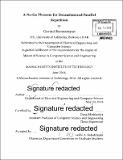A no-go theorem for derandomized parallel repetition
Author(s)
Ramnarayan, Govind
DownloadFull printable version (3.364Mb)
Other Contributors
Massachusetts Institute of Technology. Department of Electrical Engineering and Computer Science.
Advisor
Dana Moshkovitz.
Terms of use
Metadata
Show full item recordAbstract
In this work we show a barrier towards proving a randomness-efficient parallel repetition, a promising avenue for achieving many tight inapproximability results. Feige and Kilian (STOC'95) proved an impossibility result for randomnessefficient parallel repetition for two prover games with small degree, i.e., when each prover has only few possibilities for the question of the other prover. In recent years, there have been indications that randomness-efficient parallel repetition (also called derandomized parallel repetition) might be possible for games with large degree, circumventing the impossibility result of Feige and Kilian. In particular, Dinur and Meir (CCC'11) construct games with large degree whose repetition can be derandomized using a theorem of Impagliazzo, Kabanets and Wigderson (SICOMP'12). However, obtaining derandomized parallel repetition theorems that would yield optimal inapproximability results has remained elusive. This paper presents an explanation for the current impasse in progress, by proving a limitation on derandomized parallel repetition. We formalize two properties which we call "fortification-friendliness" and "yields robust embeddings". We show that any proof of derandomized parallel repetition achieving almost-linear blow-up cannot both (a) be fortification-friendly and (b) yield robust embeddings. Unlike Feige and Kilian, we do not require the small degree assumption. Given that virtually all existing proofs of parallel repetition share these two properties, our no-go theorem highlights a major barrier to achieving almostlinear derandomized parallel repetition.
Description
Thesis: S.M. in Computer Science and Engineering, Massachusetts Institute of Technology, Department of Electrical Engineering and Computer Science, 2016. Cataloged from PDF version of thesis. Includes bibliographical references (pages 45-46).
Date issued
2016Department
Massachusetts Institute of Technology. Department of Electrical Engineering and Computer SciencePublisher
Massachusetts Institute of Technology
Keywords
Electrical Engineering and Computer Science.